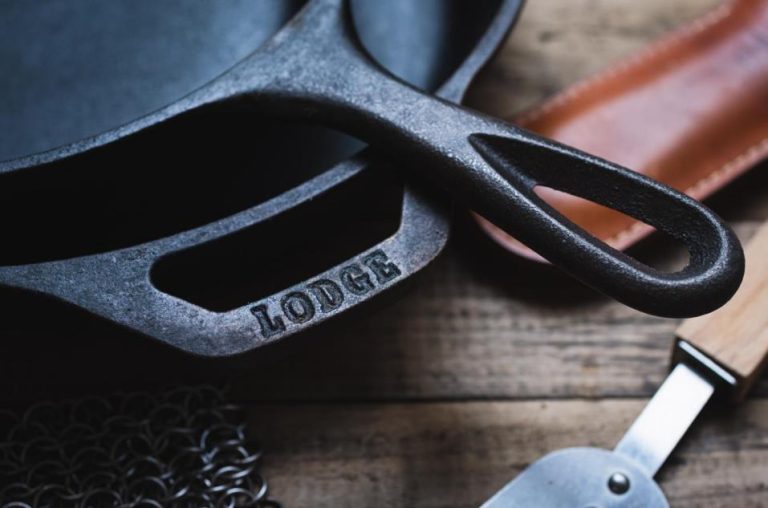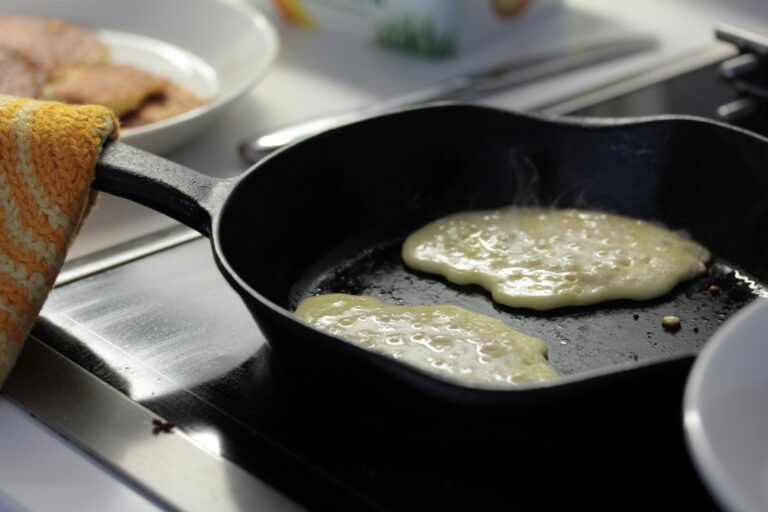Cast iron skillets have been renowned for their ability to sear and brown foods. They are highly durable and accomplish tasty meals with their superior ability to retain heat. These cooking instruments have been around for centuries, with the use of cast iron cookware dating back to 200 BC.
The core principles of making a cast iron skillet haven’t changed much. In short, the molten metal gets poured into a mold in the shape of the desired skillet. The tools utilized for this process got more sophisticated over time, but the fundamentals are still the same.
This article will guide you through how cast iron skillets are made in today’s manufacturing. Let’s get right into it!
What is cast iron?

Cast iron is a group of iron-carbon alloys with a carbon content higher than 2%. What makes it unique for cookware is its ability to retain and distribute heat evenly.
While it’s heavier and more brittle than other metals, it’s incredibly durable and, when properly seasoned, naturally non-stick.
There are different types of cast iron, but gray cast iron is the most common in cookware. It has excellent thermal mass, meaning once it heats up, it stays hot, ideal for tasks like searing, frying, or baking.
Because of its rugged construction and reliable performance, cast iron has earned a permanent place in both home and professional kitchens.
Whether you’re flipping pancakes or roasting over an open fire, a cast iron skillet delivers consistent results every time.
Wholesale & Custom Cast Iron Cookware, Straight From The Factory
Build your brand with a trusted OEM/ODM partner since 1993. Get your free quote today.
How are cast iron skillets made

From molten metal to market-ready cookware, cast iron skillets go through a fascinating transformation that combines centuries-old techniques with modern-day refinements.
Below is a step-by-step look at the process, along with insights into how each stage affects product quality and sourcing decisions.
1. Melting raw materials
The journey begins in the furnace. Foundries load a mix of pig iron, recycled steel, and cast-off castings (defective pieces from previous batches) into a high-temperature smelter. Pig iron provides the essential high-carbon content that gives cast iron its signature hardness and heat retention. Steel balances the composition, making the final skillet less brittle.
Some manufacturers also add silicon or other alloys to influence casting behavior and surface durability. The mix is melted at temperatures above 2,500°F (1,370°C), often in induction furnaces, which use magnetic fields for even, rapid heating.
During smelting, impurities like rust, slag, and sand rise to the surface. Workers or automated skimmers remove these, ensuring a clean pour and preventing defects in the final product.
2. Sand mold creation
While the metal melts, workers prepare the molds. These are usually two-part sand molds crafted using fine, heat-resistant green sand. The sand is packed tightly around a cast-iron skillet pattern to form the cavity. After removing the pattern, the top and bottom mold halves are joined, leaving a small channel (sprue) for pouring.
Why sand? Because it’s reusable, holds intricate details, and can withstand the extreme heat of molten iron without melting. Many foundries reuse the sand after filtering it for leftover iron or debris.
3. Pouring molten iron
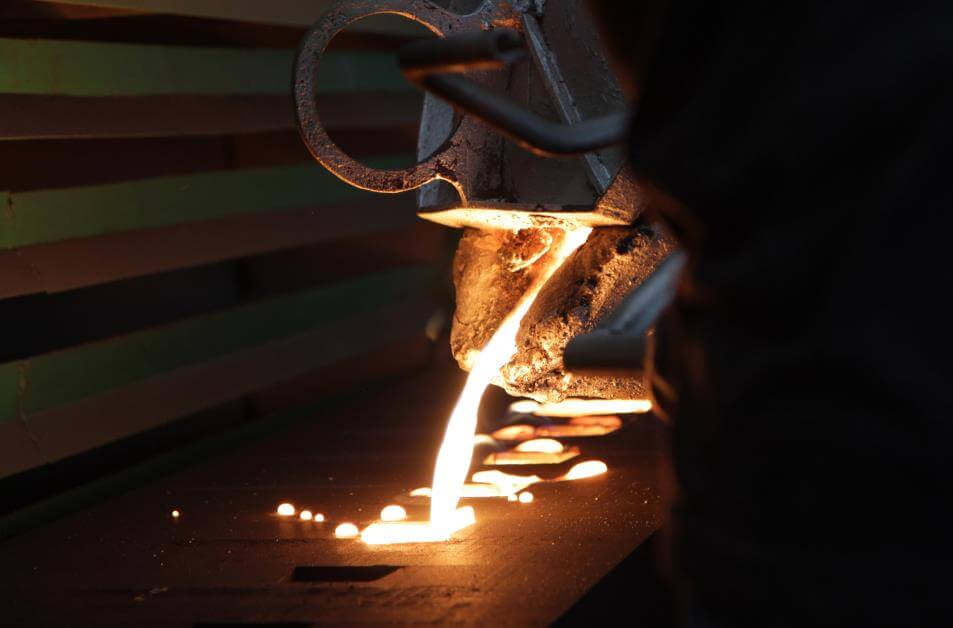
With molds ready and iron purified, it’s time for the pour. Timing and technique are critical here. Pouring too slowly risks solidification mid-pour, while pouring too quickly creates turbulence and air pockets that weaken the skillet.
Larger factories like Lodge automate this step for consistency. Smaller or artisan producers often pour by hand, relying on the skill of the worker to maintain proper flow rate, angle, and temperature.
The filled mold is then left to cool for several minutes to an hour, depending on the size and complexity of the casting.
4. Shakeout and part removal
Once the metal solidifies, the mold goes through a shakeout process. Vibrating machines or manual tools break apart the sand mold, freeing the rough skillet inside. This “casting” still contains seams and sand residue, but its basic shape is complete.
Spent sand is either discarded or recycled after cleaning, while any mispours or rejects are returned to the melt pile to start again.
5. Sand cleaning and shot blasting
Next, the skillet undergoes two cleaning phases:
- Rough cleaning: The casting is hung on a conveyor and blasted or shaken to dislodge loose sand.
- Shot blasting: The skillet enters a chamber where steel beads (shot) hit its surface at high velocity, scrubbing away stubborn sand and smoothing out minor imperfections.
This step is vital for both safety and aesthetics. Leftover sand can cause grit in food or wear down the seasoning layer. A clean surface also ensures better adhesion during seasoning.
6. Grinding and finishing
Now the skillet goes through surface refinement. Skilled workers or machines grind off any burrs, rough seams, or metal “flash” left from where the mold pieces met.
Some manufacturers polish the cooking surface to make it smoother, while others retain a rougher texture to help seasoning stick better.
Key surface areas include:
- The rim (for comfort and balance)
- The bottom (for stovetop contact)
- The cooking surface (for food release and even heating)
Some manufacturers may skip polishing for rustic appeal, while others use acid baths or mechanical polishers for a smoother, premium finish.
7. Pre-seasoning (optional but common)
At this stage, many manufacturers apply a factory seasoning, especially in western markets. A thin layer of vegetable oil is sprayed on the skillet, then baked at high heat (around 400°F/200°C or more) to polymerize the oil and create a non-stick patina.
Benefits of factory seasoning:
- Protects against rust during shipping
- Makes skillets “ready to use” out of the box
- Adds visual appeal with a glossy black finish
Manufacturers can use flaxseed oil, soybean oil, or even synthetic coatings depending on the target market. Factory seasoning is often a selling point in retail packaging.
8. Inspection, packaging, and shipping

Finally, the skillet undergoes quality control checks to ensure there are no cracks, warps, or irregular surfaces. After passing inspection, it’s ready for packaging.
Some manufacturers brand their logo into the base or handle. Others apply a product sticker or include a paper insert with care instructions.
Once boxed and palletized, the skillets are sent off to wholesalers, retailers, or directly to sourcing agents.
Wholesale & Custom Cast Iron Cookware, Straight From The Factory
Build your brand with a trusted OEM/ODM partner since 1993. Get your free quote today.
Advantages of cast iron skillets
- Excellent heat retention – Cast iron holds heat exceptionally well. Once hot, it stays hot, making it ideal for searing, frying, and slow cooking. This consistent heat ensures even browning and crisp textures.
- Versatile across heat sources – You can use it on gas, electric, induction, in the oven, on a grill, or over a campfire. This flexibility makes it suitable for a wide range of recipes and cooking styles.
- Naturally non-stick – When seasoned properly, cast iron develops a natural, chemical-free non-stick coating. This surface improves over time and doesn’t wear off like synthetic coatings.
- Extremely durable – Cast iron skillets can last a lifetime—and often get passed down generations. They’re resistant to scratches and can be restored even if they rust.
- No toxic coatings – Cast iron contains no Teflon or synthetic materials. It’s a safer choice for those avoiding chemicals in the kitchen.
- Adds dietary iron – Cooking with cast iron can boost the iron content in your food, which is beneficial for people with iron deficiencies.
Disadvantages of cast iron skillets
- Heavy and bulky – Cast iron skillets are significantly heavier than stainless steel or non-stick pans. This makes them harder to handle, especially for flipping food or cleaning.
- Takes time to heat up – While it retains heat well, cast iron is slow to heat initially. You’ll need patience before it reaches your desired cooking temperature.
- Requires regular seasoning – To maintain its non-stick surface and prevent rusting, cast iron needs to be seasoned regularly with oil and heat, something many modern cooks find inconvenient.
- Not dishwasher-safe – Cast iron can’t be washed like other pans. It must be hand-washed and dried immediately to avoid rust, which adds an extra step to cleanup.
- Reactive with acidic foods – Tomatoes, vinegar, and citrus can strip the seasoning or react with the metal, leaving behind a metallic taste if the skillet isn’t well-seasoned.
Cast iron vs. Other cookware types
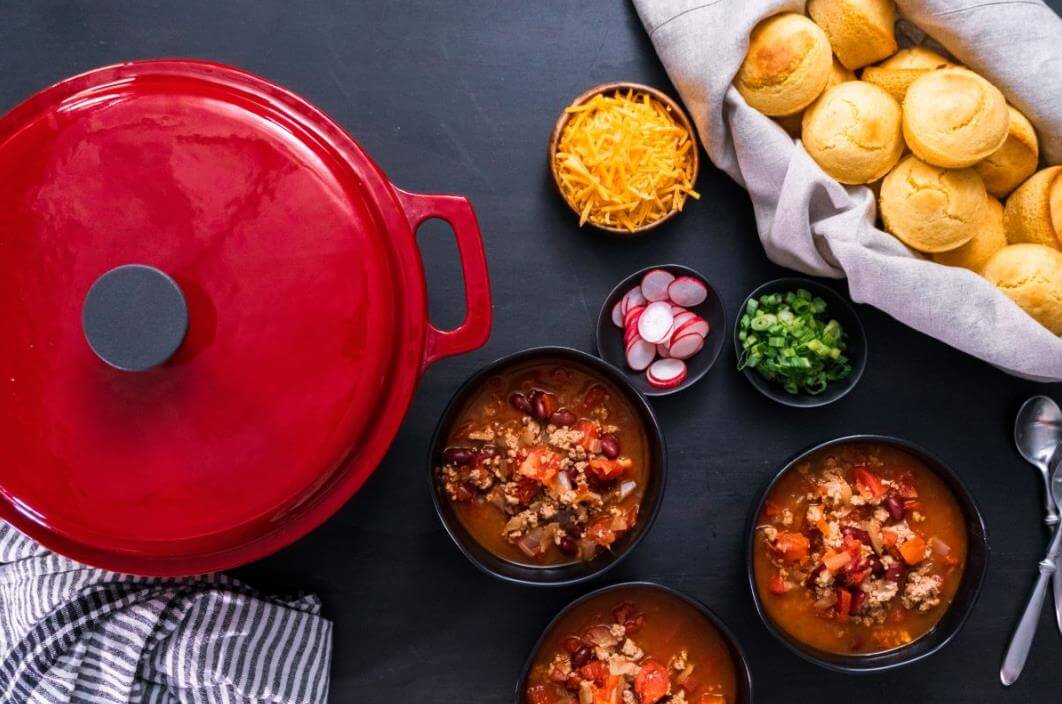
Cast iron skillets have a reputation for durability and performance, but how do they compare with other popular materials like stainless steel, non-stick, or carbon steel?
Each cookware type has its strengths and trade-offs depending on your cooking needs. Here’s a breakdown to help you see where cast iron shines, and where it might not.
Cast iron vs. stainless steel
Cast iron excels at heat retention and even cooking, making it great for searing, frying, and slow-cooked meals.
Stainless steel, on the other hand, heats up faster and is better for boiling, sautéing, and deglazing. It’s also lighter and dishwasher safe.
If you’re cooking delicate sauces or acidic foods, stainless steel is often the better choice. But for browning and holding steady heat, cast iron wins.
Cast iron vs. non-stick
Cast iron can develop a naturally non-stick surface over time with seasoning, but it requires more maintenance.
Non-stick cookware is effortless to clean and perfect for cooking eggs, pancakes, or low-oil dishes.
However, non-stick coatings can wear down or get damaged easily, while cast iron can last for generations with proper care.
Cast iron vs. carbon steel
Carbon steel and cast iron are very similar, they’re both heavy-duty and require seasoning.
Carbon steel heats up faster and responds to temperature changes more quickly, which is useful for stir-frying or cooking with precision.
Cast iron, meanwhile, holds heat longer and is more stable, ideal for recipes that need consistent temperature.
Cast iron vs. aluminum
Aluminum cookware is lightweight, heats up fast, and is very responsive to temperature changes. It’s great for quick meals and everyday use.
But it doesn’t retain heat like cast iron and may warp under high heat.
Cast iron, though heavier, delivers a more stable cooking surface and works well on all stovetops, including induction.
Cast iron vs. ceramic cookware
Ceramic cookware is often favored for its smooth surface and non-reactive coating, making it ideal for cooking acidic foods.
However, ceramic is more fragile and prone to cracking or chipping.
Cast iron is nearly indestructible, great for high heat, and more versatile if you’re looking to go from stovetop to oven with ease.
Wholesale & Custom Cast Iron Cookware, Straight From The Factory
Build your brand with a trusted OEM/ODM partner since 1993. Get your free quote today.
Should you sell cast iron cookware?
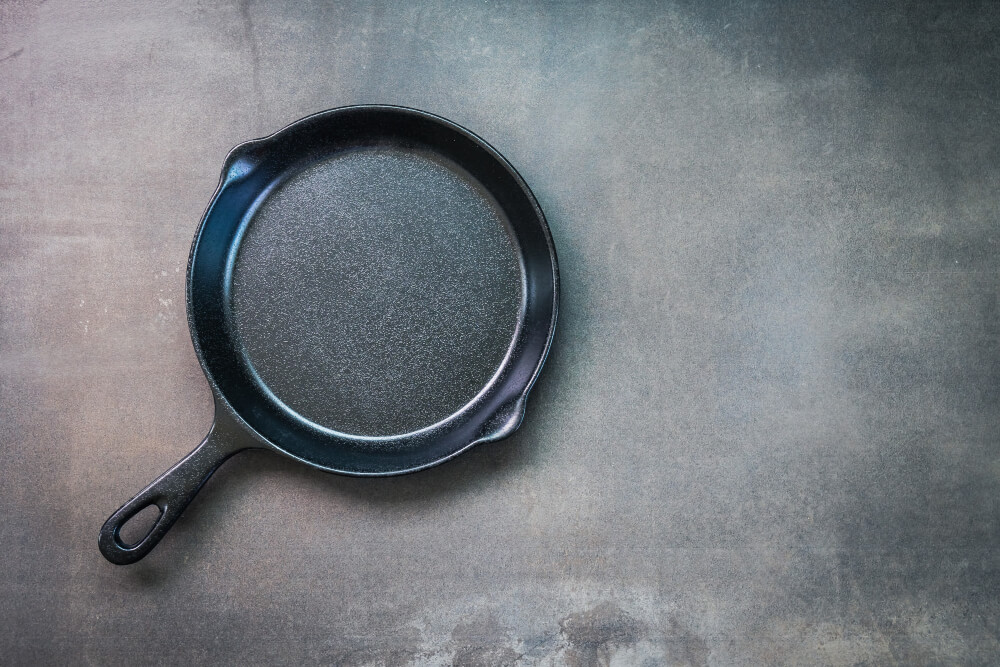
Cast iron cookware has been at the center of cooking for centuries. Although non-stick and other corrosion-resistant materials stole the spotlight from it for a period, cast iron has prevailed.
Selling cast iron cookware is a must for any store that sells cookware or other cooking products. While some of your customers might not know what cast iron has to offer, cooking on a naturally non-stick surface that holds heat can benefit everyone.
Cooks favor this aspect of cast iron cookware the most and take pride in their cast iron skillets as they age. Once a cast iron skillet enters a kitchen, it has the potential to serve for life. Cast iron skillet sears and cooks foods to perfection and is highly durable. These alone make it a must-have for any kitchen – and naturally for your store.
Source cookware from LeeKnives
Cast iron skillets have earned their place in both home and professional kitchens for a reason, they’re durable, dependable, and perfect for high-heat cooking.
Whether you’re searing steak or baking cornbread, cast iron delivers consistent results that few other materials can match.
At LeeKnives, we specialize in manufacturing premium kitchen knives and cutting boards, but our sourcing capabilities go far beyond that.
Thanks to our close ties with top cookware manufacturers in Yangjiang City, China, we can help you source a wide range of wholesale cookware, from enameled cast iron Dutch ovens to copper saucepans and more.
Looking to add cookware to your product lineup? Request a free quote today and let’s explore how we can support your business needs.
FAQs
Is it healthier to cook with cast iron?
Cooking with cast iron can add small amounts of iron to your food, which may benefit people with iron deficiencies.
However, it’s not a major source of nutrients. Its real value lies in durability and even heat distribution, not in health benefits alone.
How to clean and maintain cast iron skillets?
After each use, rinse the skillet with warm water (no soap), scrub with a brush if needed, and dry it thoroughly. Apply a thin layer of oil to prevent rust. Avoid soaking and dishwashers, as they can damage the seasoning.
Can you use cast iron on glass stovetops?
Yes, but with care. Cast iron is heavy and rough, so dragging it across glass can cause scratches or cracks. Always lift it when moving, and avoid slamming it down. Flat-bottom skillets are best for smooth top stoves.


